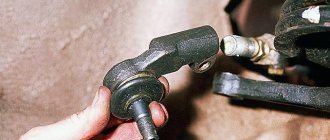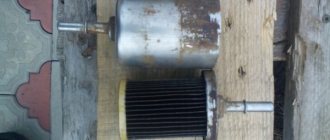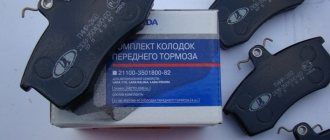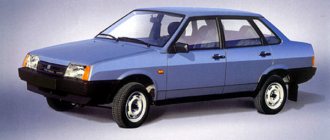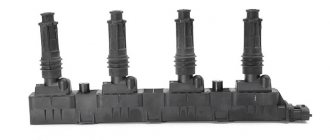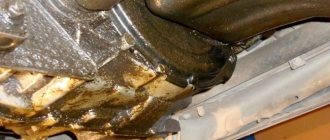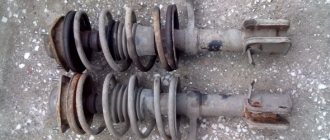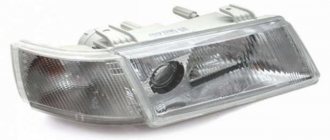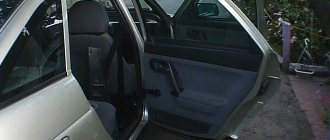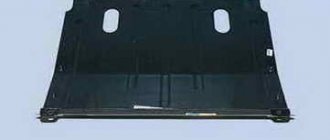- Where are they installed?
- Fault diagnosis
- Which ones are better to put
- Replacement process
- Recommendations from experienced
Initially, CV joints were positioned as elements with a very long service life. Manufacturers even assured that they could last as long as the car itself.
Photo of CV joint for VAZ 2114
But in reality, everything is not as colorful as it is described. A grenade has a life limit. What grenades, you ask. The grenade is the CV joint. People often use the concept of “grenade”. This can be explained very simply - the CV joint looks like a grenade. That's all. Therefore, do not be confused if you hear “grenade” when talking about CV joints. It is the same.
When replacement is required
If while driving your car you hear noise coming from the front of the car, be sure to check the condition of the boot. Quite often, replacing the outer CV joint boot of a VAZ 2114 becomes a daily task for service center employees.
To check, just turn the wheels in any direction and look under it. If cracks or complete damage are detected on the boot, the outer CV joint of the VAZ 2114 will definitely need to be replaced.
The presence of damage indicates that dirt has gotten inside the element. Much or little of it is no longer so important. Contamination leads to disruption of the functionality of the device.
In such situations, when the CV joint is damaged, it is strongly not recommended to continue driving under your own power. This is dangerous for you, your car and other road users. Ignoring this recommendation entails even more expensive repairs, since by the time you get to the garage or car service center, you will damage a number of other components and elements of the car.
Instructions for disassembling the unit
Before removing the wheel from the side of the faulty unit, it is necessary to loosen it using a 30 mm socket, having first pulled the metal boot out of the socket. Further steps according to the instructions:
- Use a wheel wrench to loosen the wheel bolts, jack up the car and remove the wheel. Unscrew the hub nut completely and remove the washer with a screwdriver. If your vehicle has engine oil pan protection installed, it will need to be removed. Some experts recommend draining some of the oil from the gearbox (1.5-2 liters) before removing the drive so that it does not start flowing through the spline hole when the unit is removed.
- Loosen and unscrew the tie rod ball pin nut and use a puller to press the pin out of the socket in the front suspension strut. Having turned the entire assembly by hand for convenience, unscrew the 2 bolts securing the ball joint. Holding the brake disc with both hands, carefully pull the CV joint shaft out of the mating splined part of the hub and move it to the side.
- The second end of the VAZ 14 CV joint must be removed from the splined part in the gearbox, being in the inspection ditch. To do this, you will need to place a mounting spade between the box body and the grenade, and then with a sharp jerk pull the assembly out of the socket, using the pry bar as a lever. If the part does not give in, it is allowed to tear it out of place with gentle blows of a hammer on the mounting blade. Before pulling it out, it is advisable to place a container under the gearbox, as some oil may leak out. Then the entire assembly is removed manually. A vice will be required for subsequent disassembly.
CV Joint Review
(grenades) for
VAZ
2108-2115.
Dismantling the CV joint VAZ 2114
The assembly shaft is securely clamped in a vice closer to the outer grenade if the outer CV joint is being replaced. Here you should check the condition of the boot. If there are no cracks or damage, and the rubber continues to remain elastic, then you only need to unlock one clamp that holds the boot on the grenade body.
Then it is turned outward or simply moved so that it does not interfere. Next, holding the slotted part of the grenade with one hand, apply gentle blows with a hammer along its edge from the inside. In the case when the grenade needs to be replaced, there is nothing special to worry about; you can safely hit it until it comes off the shaft splines. The boot on which defects are found is turned back out, the second clamp is loosened and the part is removed from the shaft. The inner CV joint is disassembled in exactly the same way as the outer one, you just need to clamp the shaft in a vice near the grenade itself.
What to choose?
To replace the inner or outer CV joint on a VAZ 2114, a new element will be required. To be fair, we note that the most suitable and high-quality CV joints for the VAZ 2114 model are produced by the manufacturer, that is, AvtoVAZ.
But here comes the most important disappointment - they are not for sale. The only option is to go to a specialized VAZ official car service center. But from the point of view of financial costs, it is not the most reasonable decision.
In addition, there is now a fairly wide range of analogues on the market. Judging by the reviews of VAZ 2114 owners, special attention should be paid to CV joints produced by such companies as:
Photo of GKN CV joint for VAZ 2114
Replacement
Armed with new CV joints, also collect a set of necessary tools and materials. It will include:
- Set of heads;
- Spanners;
- Shoes;
- Dry rags;
- Grease for CV joints;
- Jack;
- Anthers.
CV joint arrangement diagram
Now let's get down to work on replacing the CV joints:
- Determine the location where the repairs will be carried out. This could be an overpass, a garage with an inspection hole, or a room with a car lift.
- Stop the engine and apply the handbrake. Use chocks to block the wheels.
- Using a wheel wrench, remove the wheel bolts.
- Raise the required part of the car with a jack.
- Loosen the nut in the center of the CV joint. Keep an eye on the puck so you don't lose it. It is not included with the new CV joint.
- Armed with 13mm wrenches, unscrew the fasteners of the upper part of the ball joint. It is not necessary to perform a similar procedure with the lower part, since it will not interfere with the repair process.
- Using a pry bar, slightly rip the grooves off the support and move them aside.
- Knock the hub off the CV joint splines. To do this you will need a hammer and some kind of wooden stand.
- Remove the old damaged CV joint.
- Check for damage to the stem.
- Remove any remaining lubricant from the rod using a dry rag.
- Place a new grenade in the new location. This assembly should include a CV joint, boot, clamps, nuts, and retaining rings.
- When assembling the unit, do not forget to use high-quality lubricants. There shouldn’t be too much of it, but you shouldn’t feel too sorry either.
- Reassemble the parts in reverse order.
- By changing the CV joints, you can simultaneously check the condition of the brake pads. If they are in a sufficiently worn condition, it is advised to replace them at the same time. Anyway, you have already dismantled the knot.
- After completing the repair, check the car in action.
- It’s not uncommon for craftsmen without much experience to leave behind supposedly unnecessary parts after reassembly. Please note that everything that remains after assembly, and that is not the released elements that you replaced with new ones, has its place in the design of the car. Therefore, check where exactly these “extra” elements come from and install them in their rightful place.
A grenade flies out of the box on a VAZ-2112, causes, repairs, photos
Repair manual for VAZ 2108, 2109, 2114, 2115 Wires and fuses
It is necessary to change the constant velocity joint (CV joint, or popularly a grenade) on a VAZ-2112 when a peculiar knocking (crackling) noise appears in this part. If such repairs are not carried out on time, the grenade may fly out of its place while moving. Then you will have to call a tow truck to transport the car to the service station, since it will no longer be able to drive on its own.
Why are grenades flying?
The grenade flew out and the boot broke
The fact that the grenade is out of order is indicated by a knocking sound in the area of the front wheel when turning, as well as when the clutch pedal is released while the car is standing still. A crash will be heard in the area of the front wheel where the grenade was fired.
In this case, you should check with the speed turned on (the car must be placed on a lift); if the drive spins, but the wheel does not, then the external grenade has failed. If the drive is stationary at switched on speed, then the internal grenade has broken.
The internal grenade just “flies” out of the gearbox. Or rather, it crumbles, one part remains in the gearbox, the other on the wheel drive. Sometimes a situation arises when the retaining ring falls apart, in this case the grenade will also fly out. The breakdown is not associated with incorrectly selected oil in the gearbox.
Grenade replacement
Trialli external grenade - seems to be praised.
When you hear a cracking sound in the grenade, you can fix this breakdown yourself, without resorting to the services of a specialist. To do this, follow simple steps that will be described below.
Process
Don’t forget to check whether the CV joint kit includes a separate boot and clamps. If not, then you will have to buy it all.
Separate boot and clamps
- The car should be raised from the side where the grenade failed. In this case, wheel chocks should be placed under the rear wheels.
- Remove the protective cap from the wheel and unscrew it.
- Remove the hub nut. This may require a strong tool, since the nut may become welded to the axle during operation. You can also use a special wrench for this (weld the head at “30” to the chisel and use a long wrench).
- Unscrew the ball joint (lower) bolts from the steering knuckle.
- Turn the wheel to its extreme position.
- Pull the steering knuckle together with the strut and pull out the CV joint spline from the hub.
We took the CV joint out of the hub - Using a pry bar, you need to pull out the drive splines from the gearbox. If you need to change two grenades at once, then after removing the drive from one side, you need to fix the box with a technological lock. You can use an old CV joint for this. If this procedure is not done initially, the gears on the differential will shift, and then during assembly it will be impossible to insert the CV joints themselves.
- After removing the drive shaft, it must be clamped in a vice.
- Remove protection from grenades. If the anthers are torn, you can simply cut them off and then install new ones. If they are whole, then you should simply wrap them, being careful not to damage them.
- Using a hammer, knock the CV joints off the drive shaft.
- Next, a new spare part is installed.
The CV joint must first be lubricated. You also need to put fresh lubricant in the boot. It is recommended to use MoS2. It will last for the entire service life of the hinge. We check the condition of the separator on the grenade and fill it with lubricant - The boot is attached to the grenade using clamps.
We put on the “fashionable” transparent ACVA boot. Reviews are mostly positive - If the inner CV joint is being assembled, then do not forget about the plastic plug that is placed on the end of the shaft.
The old grenade is on the right, and the new one is on the left, they differ in height - A retaining ring is also installed on the inner CV joint.
- Then the assembled part is placed in the box drive.
It should be seated on the slots to the base. To do this, you can lightly hit it with a hammer, placing a block of wood on it. The inner CV joint is already in the gearbox - Further assembly is carried out in the reverse order of disassembly.
It is also worth replacing the nut that holds the hub with a new one. It must also be tightened in accordance with the requirements of the car manufacturer.
Stabilizer link failure and grenade flying out
As a result of the stabilizer bar breaking, the wheel went to the side, and grenades flew out with it. The anthers also came to an “end.”
Knowing these points and adhering to the given rules, you can replace CV joints on your own and without resorting to the help of a specialist.
Advice from experienced motorists
There are some useful tips on this matter that are worth listening to.
- If you hear a characteristic crunch while driving in a straight line, it means the CV joint has failed. If this crunching noise is heard only when turning, then the problem lies in a faulty joint.
- Before installing a new CV joint, treat the grenade landing site with lubricant. This significantly extends its service life.
- To adjust the CV joint and seat it properly, use wooden attachments. If this is not done, the risk of damaging the new element is very high.
- The boot should be installed as tightly and efficiently as possible. If you don't do this, dirt and dust will soon get there. These components will quickly render it unusable, and repair work will have to be carried out again.
- The lock nut on the hub is tightened with a special torque tool. Moreover, tightening is carried out strictly with the parameters specified in the instruction manual for your VAZ 2114 modification.
- During a routine inspection of the technical condition of your car, be sure to pay attention to the condition of the clamps and rubber elements to ensure their integrity. Such seemingly insignificant components can lead to serious consequences and significant financial costs.
- The purchase of spare parts, including CV joints, should be made only from trusted sellers, certified distributors. If you buy a bad, low-quality part, just trying to save money, you will have to pay even more to eliminate the consequences that the use of such elements led to.
The CV joint is an important component of any car, and replacing it even on your own is not particularly difficult.
Knocking in the chassis is a frequent companion in life for owners of the VAZ 2114. Many elements that can cause knocking, bad roads, and low-quality parts can cause extraneous noise in the suspension. A common source of the problem is the angular velocity distributor, or CV joint (grenade).
The process of replacing a part is simple, so you can change it yourself. The question is often asked which CV joint for the VAZ 2114 is better: regular or tripoid. Among the most common arguments: tripoid is more reliable, but it hums and vibrates at high speeds. The regular one is less reliable, but the car handles better at high speed. However, you can find opposing opinions and arguments on this matter.
There is no clear answer which type is better. Operation in harsh conditions showed that there is no fundamental difference in driving sensations and reliability. The main thing is to buy a high-quality grenade made of well-hardened metal, install it correctly and monitor the safety of the anthers.
Why does the CV joint start to crunch?
Constant velocity joints, both internal and external, are quite reliable mechanisms, and with proper care their service life can be calculated in years. In some cases, it is even comparable to the service life of the entire car. However, this circumstance directly depends on the care and operating conditions of CV joints.
One of the reasons why joints fail prematurely is an aggressive driving style and/or poor road surface on which the car is driven. As mentioned above, CV joints experience maximum load during sharp turns and high torque from the engine (in other words, when the driver enters a turn “with gas”). As for bad roads, they can damage not only the car’s suspension, but also the CV joint, since a similar situation is created here. For example, the driver accelerates the car through the CV joint, and at this time the wheel oscillates significantly in the vertical plane. Accordingly, under such conditions the hinge also experiences increased load.
Torn CV boot and lubricant splashed from it
The second reason why the CV joint begins to crunch is damage to its boot . This is especially true for the outer CV joint, since it is located in close proximity to the wheel, and accordingly, a significant amount of dust and dirt gets on its body. Under the boot there is a lubricant, which, when moisture and dirt gets into it, immediately turns into an abrasive compound that begins to destroy the surfaces of the internal joint components. This should under no circumstances be allowed. It is necessary to regularly check the condition of the boot in the inspection hole, as well as the presence of lubricant in it. Also check if there is any grease on the wheel rims and parts close to it, because often when the boot is torn, it simply splashes onto the mentioned surfaces.
The third reason why the “grenade” crunches when turning is the natural wear of its internal components under normal operating conditions. This is especially true for cheap Chinese or domestic CV joints. If the mechanism is made of “raw” or low-quality metal, then the service life of such a unit will be short. In the outer hinge, at the point of contact between the balls and the cage, a groove gradually begins to appear. As a result, the designated balls roll very freely, along grooves having a larger diameter than the balls themselves. This rolling is perceived by the human ear as a kind of crunch.
Detecting play on the CV joint
An additional sign of partial failure of the CV joint is the appearance of play on the shaft or axle shaft. It is quite easy to detect it by driving the car into the inspection hole and tugging at the corresponding parts with your hand.
Fault diagnosis
The VAZ 2114 has 2 external and 2 internal CV joints. First you need to determine which one is knocking. The optimal test would be on a suspension diagnostic stand. If this is not possible, diagnosis by ear is possible.
Two signs indicate a grenade malfunction in a VAZ 2114:
- the sound resembles a crunch;
- It usually appears when turning.
The simplest and most accurate way to do a garage check is as follows:
- Place the car on a flat surface;
- Turn the wheels to one side (to the middle position or a little further);
- Drive off with medium speed. It is worth remembering that starting too smoothly may not reveal a crunch due to insufficient load on the CV joint, and starting too abruptly may lead to the drive flying out of the wheel.
- Repeat the operation by turning the steering wheel in the other direction. The appearance of a crunch indicates a malfunction of the outer CV joint on the side in which the steering wheel is turned.
The easiest way to diagnose CV joints
All that is required is to make the following simple movements, and you will most likely be able to find out whether it is worth changing the CV joints, or whether they are still in good condition:
- The first step is to align the wheels straight.
- Jack up one of the front wheels.
- Put the car in neutral, put on the handbrake, and it is advisable to use wheel chocks. There is no such thing as too much security.
- Start the car engine.
- Depress the clutch, engage first gear and smoothly release the clutch pedal (the suspended wheel should begin to spin).
- Slowly and smoothly press the brake pedal, thereby creating a load on the CV joint. If any knocking or extraneous sounds appear, then the internal CV joint is faulty. If the car just starts to stall slowly, without creating any dubious situations, then everything is fine with the internal CV joint.
- Turn the steering wheel to the side as far as it will go. Similarly, we begin to slowly slow down. If the inner CV joint is faulty, then it will continue to knock, and if an additional sound appears, then this is already the outer CV joint making itself felt. If additional sound does not appear, then move on to the next step.
- Next, turn the steering wheel in the opposite direction as far as it will go. We do the same thing.
- Having dealt with the selected side, put the car in neutral, turn off the car, lower the wheel to the ground and carry out all the operations with the second wheel.
Replacement
It is better to change a grenade yourself with an assistant.
- remove the wheel, remove the wheel bolts and the hub nut washer;
- unscrew the ball from the steering knuckle;
- pull out the splined end of the outer CV joint;
- pull out the drive with the internal CV joint from the gearbox;
- if you plan to remove both drives, remove the internal grenade from the drive and insert it into the gearbox so that the differential does not move after removing the second drive;
- remove or cut off the anthers, thoroughly clean all hinges with a special liquid or just gasoline;
- when filling the CV joint, use a special lubricant suitable for these purposes; ordinary lithol does not have the required temperature characteristics;
- the retaining rings of each CV joint and the hub nut must be replaced;
- The inner CV joints are inserted into the gearbox until they are completely fixed; when adjusting, you can use a hammer with a wooden spacer.
It is quite possible to diagnose and replace a CV joint with your own hands. This does not require sophisticated car mechanic skills and engineering knowledge, but it allows you to get in touch with the car, see and feel how it works. Whatever the reason for the crunching sound, you need to check the condition of the grenade as quickly as possible. Delaying this will almost certainly mean bringing the part to the point of complete wear, and timely repairs will allow you to get by with “little loss.”
In the design of modern front-wheel drive cars and all-wheel drive crossovers, CV joints (or “grenades”) are used to transmit rotational motion from the engine to the front wheels. The joints ensure a stable speed of rotation of the drive shafts, regardless of the angle of rotation of the wheels and movements of the suspension. This type of drive consists of two hinges, internal and external, which are attached to the axle shaft. The inner CV joint is inserted into the gearbox, and the outer one is fixed in the wheel hub.
The design of the internal and external CV joints is different: The internal CV joint compensates for vibrations of the engine and gearbox, as well as longitudinal movements of the axle shaft when cornering, but has a small bending angle. The external hinge device does not allow axial movements of the working parts, but provides continuous transmission of torque when the relative position of the shafts changes over a wide range (from 40 to 70 degrees).
There are two main modifications of this vehicle chassis unit: a six-ball CV joint and a tripoid constant velocity joint. To determine which CV joint is better, tripod or ball, you need to familiarize yourself with their operating properties.
How to Change the Inner CV Joint on a VAZ 2115
Changing the internal grenade on a VAZ-2114: removing the reflex seam with your own hands
Grenade or connecting rod. This is an automobile part that transmits torque from the engine and gearbox to the wheels of the car. Replacing this element on a VAZ-2114 is a rather complex procedure and requires certain skills. This article explains how to properly replace a joint on a car, as well as how to choose the right parts.
Video replacement of the front-wheel drive VAZ 2113-2114-2115 family
The video will tell you how to replace a grenade on a car, as well as its features and nuances.
The process of replacing a grenade in detail
First, you need to decide on the tools before you can begin the replacement process. So, what you will need when replacing the internal grenade: head and head 13-17, as well as 30; keys 17 and 19; connector; lamp; pliers; CV joint lubricant; ball wrench; and the spare part itself.
Leave!
Now that everything is complete, you can start the replacement process:
- Remove the lower engine protection.
- Drain the gearbox.
- Use a wrench to remove the wheel.
- Unscrew the head 30 fastening nut external constant speed joint.
Replacing the internal CV connection on VAZ 2108, 2109, 2110, 2112, 2114.
Replacing a window repair kit for an internal CV joint on a VAZ
2108, 2109, 2110, 2112.
Replacing the grenade launcher (internal hinge) of the VAZ 2114
I'll show you how to replace the internal grenade on a VAZ
2108-
2115
. My videos. it is useless as a repair.
Remove the nut securing the connection to the hub
Unscrew the fasteners and remove the ball joint from the fist
Removing the constant speed connection from the hub
Use a crowbar to remove it from the inner joint seating bracket
Unscrew load clamp for easy grenade access
CV joint lubricant LUX
original
2108-2215056. original catalog number of internal grenade for VAZ-2114. Average cost. 2000 rubles Installation of the chair becomes easy and does not require any changes.
CV joint with ball bearings
In general, the part is a housing with a driven shaft (trunnion), into which a holder (knuckle) is inserted. On the inner surface of the body and the outer side of the cage there are guide grooves along which six balls move, held by the separator. The splined part of the drive shaft is inserted into the central hole of the knuckle. To ensure stable operation, the installed hinge is filled with lubricant and sealed with a rubber or silicone boot. For ball CV joints, thick lubricants with molybdenum disulfide are used.
Tripod CV joint with needle bearings
A tripoid grenade design is often used as an internal hinge on modern cars:
In the body of such a hinge there is a three-beam fork, pressed onto the splines of the driven shaft. Three working rollers are attached to the ends of the fork, which can move along the guide grooves of the body when the unit is rotated or axially displaced.
To protect tripod joints from wear and metal scuffing, special synthetic compounds without solid additives are used.
How to repair a CV joint
Damage to the internal parts of the hinge most often leads to a complete replacement of the mechanism. However, this only happens with significant wear. In most cases, it is recommended to simply replace the CV joint grease and boot. This is often enough to get rid of the annoying sound and make it easier for the parts to interact.
Therefore, if knocking or clicking sounds appear on one of the four CV joints (we will assume that you have already found out which one), you must perform the following steps:
New inner CV joint
- Drive the car into the inspection pit in order to check the integrity of the boots and the presence of lubricant splashes from under them on nearby surfaces.
- If traces of grease are visible on the boot or other parts, it is necessary to remove the CV joint. Next, disassemble it, remove the boot, wash the internal parts and surfaces, change the lubricant and boot.
- If during the inspection process you find significant play and/or damage to the working surfaces of the parts, you can try to polish them. However, as practice shows, this procedure is ineffective, since you cannot eliminate significant waste with anything. Therefore, the best recommendation would be to completely replace the CV joint .
You can replace the lubricant and boot yourself, as the procedure is simple. The main thing is, when disassembling, do not forget to wash all internal parts and surfaces with gasoline, thinner or other cleaning liquid. And only then apply new lubricant. However, if you are dismantling and replacing the lubricant for the first time, then it is better to have a more experienced car owner or technician with you. Or have him perform the procedure and show you its algorithm. In the future, you can easily cope with such work.
Conclusion
Constant velocity joints are reliable and durable mechanisms. However, during operation, it is necessary to constantly monitor their condition in order to determine in time which CV joint is crunching or making other unpleasant sounds. After all, this indicates a malfunction in its operation. Hinge failure at the initial stage is not critical . You can drive hundreds or even a thousand kilometers with a crunch. However, you should remember that the sooner you repair or replace the CV joint, the cheaper it will cost you. In addition, do not forget about safety. Do not bring the condition of the hinge to a critical state , as this threatens you with a serious emergency situation, especially at high speed. We hope that the above information helped you figure out what to do when the CV joint crunches and accurately determine which one is faulty.
Features of the tripoid joint
Due to the use of needle bearings, tripoids are more resistant to wear, and friction losses of elements in the assembly are also reduced.
Characteristics of tripoid CV joints:
- Possible bending angle up to 18 degrees,
- Maximum axial movement up to 55 mm,
- Engine and gearbox vibration compensation more than 60%.
Also, the tripoid cannot immediately fail, immobilizing the car, which is important for lovers of off-road driving. Despite the sharp crunch and vibrations that arise, the emergency tripoid CV joint will allow you to get to the repair site under your own power.
